Audiotoop: little rouge
[ii] syntax, semantics and landscape with trains
february 05, 2010.
The second installment of 'A Little Rouge', the Audiotoop I did for Extrapool, was at Extrapool même, in the Dutch city of Nijmegen, the friday before the saturday that I railed on to das kleine in Leipzig. That was on october 16th, 2009, as part of a combined BromBron/Audiotoop event.
I took the picture that follows during Alessandro Bosetti's Audiotoop contribution of that evening, which was a performance of his piece "The Pool and the Soup" (2007).
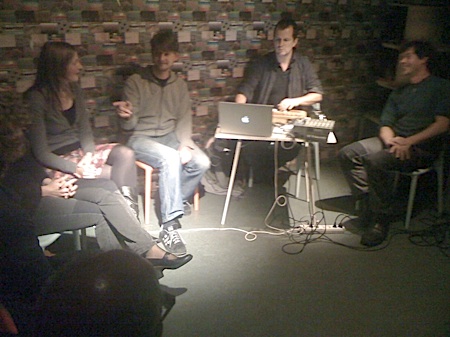
As is explained on his web site, "The Pool and the Soup" is a spoken improvisation, in which a conductor guides a number of players "through a pool of instructions". The piece may be performed by any number of people, starting from 2. At Extrapool, including Alessandro, there were 7. If I remember rightly, the role of the conductor that evening was not fixed, but rotated among the members of the ensemble, who were seated on chairs in a little half circle facing the audience. Maybe a disposition not so much as in a talk show (recommended in the piece's score), as in some sort of group therapy session. It was intimate, indeed. And effective.
The instructions (which are all described in detail in the score) are given to the players by means of a number of gestures, and apply to those players that before have been pointed out by the conductor. The score describes 15 instructions and corresponding gestures. Some of these are merely formal ('softer', 'louder', 'faster', 'slower'), but all initiate a certain kind of action by the indicated player(s). Except the four 'formal' ones, all come with a corresponding 'closing gesture'. This enables the conductor to stop the execution of the action, though it is not necessary to close an action before starting a next one.
Here are pictures of some of the gestures, that I took from Alessandro's score for the piece.
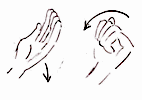 |
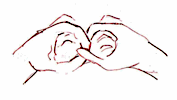 |
 |
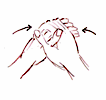 |
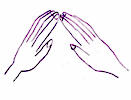 |
 |
 |
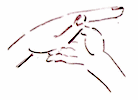 |
The first gesture (a karate
chop) is that for free speech, one of a couple of possible
starting instructions for the piece, upon which the player that has been
pointed out must start to speak from scratch about the first thing that
comes into his or her mind. The corresponding closing gesture (quickly closing
the hand) is that in the second picture, which the conductor also may use
more generally to 'stop' a player.
The third gesture (lock) tells the players involved that they should start listening, and interact with each other.
Then come three gestures that enable the conductor to musicalize
the improvisation. The first of these (fourth picture) tells the player
to choose a small sound fragment (a sample) from the speech flow
of one other player speaking at that moment, and freeze the sample into
a longer event. The second one (fifth picture) instructs a player to exactly
repeat what (s)he is doing at the moment, as in a loop. The third
one (sixth picture) asks the player to apply one musical characteristic
(like pitch or rhythm) to his or her current speech flow.
The final three gestures depicted I find particularly interesting, as they in one way or another will interfere with the
semantics of that what is being said. The gesture in the seventh picture instructs the players to systematically
misunderstand what the others say, while the final two ask for translation into another (real of fictional) language,
either of what the player him- or herself is talking about at the moment (eight picture), or of the words of another player (last picture).
Performing "The Pool and the Soup" is far from an easy task for the players involved, and it is clear that the final outcome will largely depend on their alertness and inventiveness. With only the one day of preparation, the Extrapool ensemble was admirable, and did come up with a nice flow of mime, (minimal) music and words, that at times managed to be hilariously funny.
Not unsurprisingly, and despite the very different sonic texture, the melange of words, languages and sounds reminded me a lot of Diktat, where we have the words in many different languages stored on our tapes, and manipulate them - indeed also in ways comparable to those included in Alessandro's instructions - on dictaphones. Combining this with actions performed by live speakers, as in "The Pool and the Soup", strikes me as a fascinating future option to explore.
Towards the end of the performance one of the players embarked upon a lively description of her reading of Richard Dawkins' The God Delusion. That was sort of interesting, and as I only recently had read the book myself, at several points I felt this strong urge to raise my voice from within the audience, and enter the discussion. The score indeed does include an instruction enabling a player to engage in a conversation with the audience, but - except by shouting, I guess - there is no way that an auditor can take the initiative to do so.
Maybe some next time we can be allowed to raise our hand?
...
In the triptych below there's Benjamin Gwilliam and Jason Zeh who that same evening at Extrapool presented the outcome of their BromBron work, for which they used a large table studded with a swell collection of vintage cassette and other tape-equipment. In the Extrapool's dim lighting, a few hours before the concert, with nobody else around to watch it, it was like an imaginary, deserted landscape (click the middle picture to enlarge), that for me evoked a very old memory.
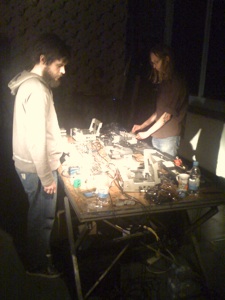 |
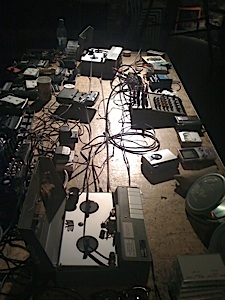 |
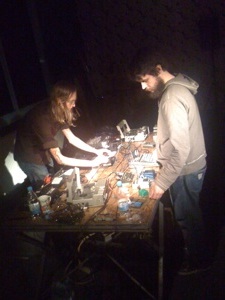 |
The view reminded me of a small room in the flat of friends of my parents. I called them uncle and auntie, but they were not, really. In the very early 1960s we went to visit them every other saturday evening. While the adults watched the saturday evening show (on German television; we did not yet have a television set ourselves at the time), I sometimes caught a glimpse of the inside of that special - nearly, but not quite 'secret' - room, when its door was ajar. The room's window was obscured, and it smelled of glue, paper, paint and plastic. Almost all of its surface was taken up by a large low table, on which there was a vast miniature mountain landscape, with houses, tunnels, forests, roads and a dense entanglement of railroad tracks. With nothing moving, in the dark of the room, the small frozen world was dominated by the ragged outlines of gray paper rocks in the distance. Closer up there was the platform of a meticulously modeled village railway station, where stood a couple of small plastic figures, that cast dim and strangely long shadows, because of the low light that penetrated from the flat's hall. I remember the figure of a man running and holding a suitcase, another one waving a folded newspaper, a woman bending as if to pick up something that had fallen, and a train conductor raising his 'ready for departure' sign. ( * )
I always remembered my watching of that still, cold and dark scene, from which somehow all life had been removed, as the second of two of the earliest moments that I vaguely became aware of something like a notion of 'death'. Fortunately, that evening in Extrapool, there were Jason and Benjamin to breathe some life into the scene, though all along the couple of short sets that they manned their landscape, the long tape loops that they set into motion continued to feel a lot like the little trains on my uncle's table.
notes __ ::
(*) In
Dutch one calls the thing I mean a 'pannenkoek' or 'spiegelei'; I do not know how one would call it
in English.
[
^ ]
tags: Audiotoop, Extrapool, Nijmegen
# .347.
smub.it | del.icio.us | Digg it! | reddit | StumbleUpon
comments for Audiotoop: a little rouge [ii] ::
|
Comments are disabled |
Médium Hang Esztétika
february 04, 2010.
As some
of you may recall, already for some years, together with Rébus, I embarked upon a
still ongoing study of electroacoustic improvisation (EAI)
as a metalanguage.
The first in a series of texts that we are writing on the subject, called
"Electroacoustic improvisation as metalanguage 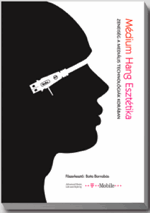 and fixed point (i)", recently appeared as part of a nice looking monograph,
edited by Barnabás Batta, and published (I think) by the Department
of Communication and Media of the University
of Szeged. The book is called Médium Hang Esztétika - Zeneiség a
mediális technológiák korában (which Google-translates
into English as "Medium Sound Aesthetics - Performance in the medial age
of technology"), and it comes along with a dedicated
web site of the same title.
and fixed point (i)", recently appeared as part of a nice looking monograph,
edited by Barnabás Batta, and published (I think) by the Department
of Communication and Media of the University
of Szeged. The book is called Médium Hang Esztétika - Zeneiség a
mediális technológiák korában (which Google-translates
into English as "Medium Sound Aesthetics - Performance in the medial age
of technology"), and it comes along with a dedicated
web site of the same title.
All of this - book and web site - are (exclusively) in Hungarian.
Rightly so, I'd say.
On the other hand though, and as a consequence, all the fine work done by
Barnabás and his collaborators, as well as the other articles in
the book remain completely inaccessible to me. Except, that is, through
the Google or some other translator. (Which of course indeed will bring across some
of the meaning of a text; it also is kind of a fun thing to do, as we all
know. But as I did indulge in the copy-pasting of auto-translations at
least once before, let me leave it here up to you.)
Apart from the 23 pages written by Rébus and myself, the 271 pages of Médium Hang Esztétika contain contributions by Ignász Ádám, Danczi Csaba László, Frank Ilschner, Philip Sherburne, Rolf Grossmann, Batta Barnabás, Mihály Kamilla, Markó Barbara, John Chowning, Kovács Balázs, Fransisco Lopez, Douglas Kahn, Simon Waters, Rónai András and Bram Timmers (for the Hungarian authors I suspect the order of first and last name to have been inversed systematically, unlike for the non-Hungarians).
You will find our paper, consisting in 17 + 1 numbered paragraphs, on pp. 57-80, under the title "Az elektroakusztikus improvizáció mint metanyelv és rögzített pont". It was translated from English into Hungarian by Danczi Csaba László.
Just to give you an idea (and to make you curious :) - here are, in English, the article's summary and its opening (the Oth) paragraph:
[ Show someone a picture of a rose, and then ask that person: “What do you see?” It will almost always be the case that the person replies: “I see a rose,” though in fact she sees (and knows that she sees) merely the picture of a rose. Now play someone a recording of a buzzing bee, and then ask that person: “What do you hear?” It will almost always be the case that she replies: “I hear a bee buzzing,” though in fact what she hears is merely the recording of a buzzing bee. Contrary to appearances, though, the two cases are not symmetrical: in the case of hearing it may very well be that the person listening does not realize that she is listening to a recording of a buzzing bee, because that fact has been kept hidden from her. ]
0. Music needs music to explain music.
Now this is how that same fragment reads in Hungarian:
[Mutasd meg valakinek egy rózsa képét, majd kérdezd meg tőle: "Mit látsz?" Szinte mindig azt fogja válaszolni: "Egy rózsát látok" – bár valójában (és ezt tudja) csupán a rózsa képét látja. Ezután játszd le neki egy felvételről a zümmögő méh hangját, majd kérdezd meg: "Mit hallasz?" Majdnem mindig azt fogja válaszolni: "Egy zümmögő méhet hallok" – bár valójában csupán egy felvételt hall a zümmögő méh hangjáról. A látszat ellenére azonban a két eset nem szimmetrikus: a hallásnál könnyen előfordulhat, hogy a hallgató egyszerűen nem veszi észre, hogy csak egy felvételt hall a zümmögő méhről, mivel a tény rejtve maradt előtte.]
0. A zenének zenére van szüksége a zene magyarázatához.
I have to admit that it gave me a truly boyish thrill and pleasure when I opened the book and there saw my own words in a language that I was utterly unable to understand.
[ Médium Hang Esztétika - Zeneiség a mediális technológiák korában, edited by Barnabás Batta. 2009. ISBN 978-963-88468-4-6 ]
tags: theory, EAI
# .346.
smub.it | del.icio.us | Digg it! | reddit | StumbleUpon
comments for Médium Hang Esztétika ::
|
Comments are disabled |